According to the late film historian Vittorio Martinelli, Maria Jacobini (1892-1944) was an island of serenity among the Italian divas. Jacobini was the personification of goodness, of simple love. Her weapon was her sweet and gracious smile. However, in some Italian and later German films, she could also play the vivacious lady, the femme fatale, the comedienne, the hysterical victim, or the suffering mother or wife.
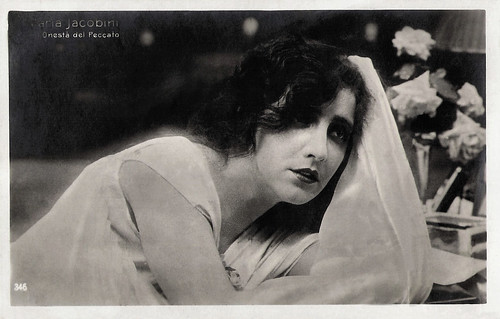
Italian postcard by Ed. Vettori, Bologna, no. 346. Sent by mail in 1926. Maria Jacobini in Onestà del Peccato/The Wife He Neglected (Augusto Genina, 1918).
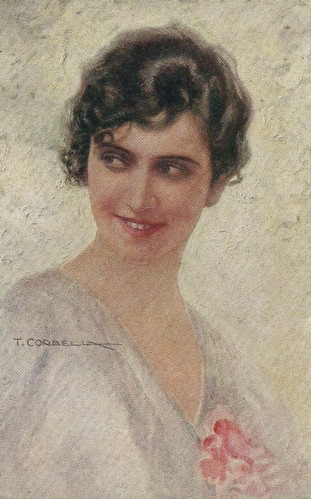
Italian postcard by Milano, Uff. Rev. Stampa, no. 891. Portrait of Maria Jacobini by Tito Corbella.
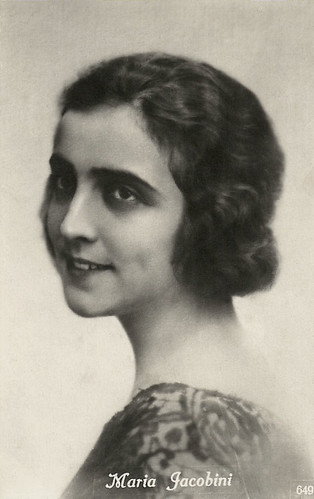
Italian postcard by Ed. Romeo Biagi, Bologna, no. 649.
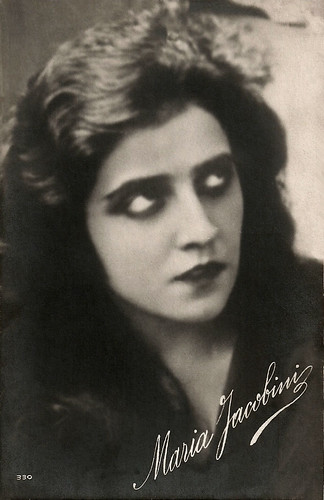
Italian postcard by Dist. Ed. SARPIC, Bucarest, Romania, no. 330.

Italian postcard by G.B. Falci Ed. for Unica - Ciocolato Talmone al latte. Photo: Pittaluga Film. Maria Jacobini in Beatrice Cenci (Baldassarre Negroni, 1926).
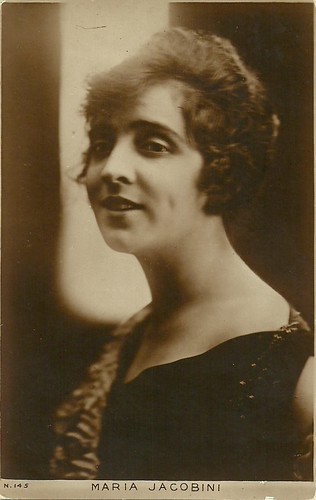
Italian postcard by Ed. Bettini, Roma, no. 145.
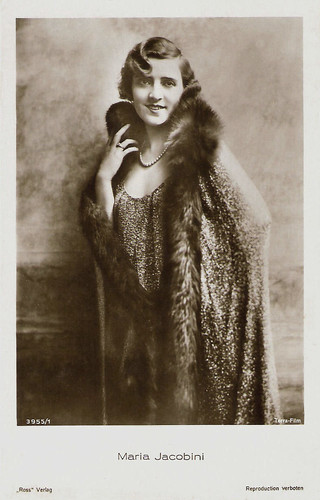
German postcard by Ross Verlag, no. 3953/1, 1928-1929. Photo: Terra-Film.
Maria Jacobini was born in Rome, Italy, in 1892. She was the sister of actress Diomira Jacobini. Their older sister Bianca had also started as an actress but interrupted her career after four films. Maria studied at the Accademia di Arte Drammatica di S. Cecilia, where her teachers were Virginia Marini and Eduardo Boutet. She made her stage debut at the company of Cesare Dondini Jr., where she mainly played secondary parts.
She was noticed by Ugo Falena, artistic director of the film company Film d'Arte Italiana. He offered her to work in the silent cinema. Her first short films were Lucrezia Borgia/Lucretia Borgia (Ugo Falena, 1910) featuring diva Francesca Bertini, and Beatrice Cenci (Ugo Falena, 1910), but her first important role was in Cesare Borgia (Gerolamo Lo Savio, 1912) again starring Bertini.
In 1912, Maria started to work at the Savoia company of Turin, as a seductive man-eater in short films like Pantera/Panther (1912), La zingara/The Gypsy (Sandro Camasio, 1912), and L'onta nascosta/The Hidden Shame (1912).
From 1913 on, she played her more dramatic roles as the lead in Giovanna d'Arco/Joan of Arc (Ubaldo Maria del Colle, 1913), In hoc signo vinces/The Triumph of an Emperor (Nino Oxilia, 1913) and Ananke (Nino Oxilia, 1915) with Leda Gys and her sister Diomira Jacobini.
Jacobini worked for pioneering film studios like Pasquali and Celio. Maria gave good performances in the melancholic Come le foglie/Like the Leaves (Gennaro Righelli, 1916) based on Giuseppe Giacosa's stage play, and in the touching Addio Giovinezza/Good-bye Youth (Augusto Genina, 1918). She made a series of films with director Gennaro Righelli such as Il viaggio/The Journey (1921), based on a novel by Luigi Pirandello, and Cainà - la figlia dell'isola/Cainà - the Daughter of the Island (1923), shot in Sardinia.

Italian postcard by Ed. A. Traldi, Milano, no. 713.
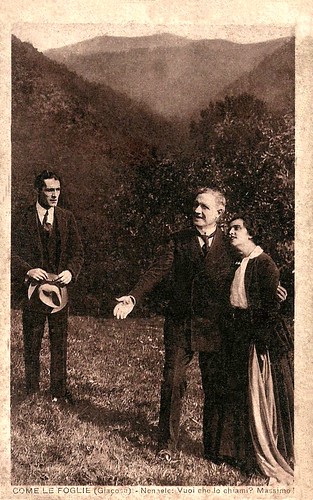
Italian postcard. Photo: Tiber Film. Publicity still for Come le foglie/Like the Leaves (Gennaro Righelli, 1917), based on the stage play by Giuseppe Giacosa. Father Giovanni (Ignazio Lupi) unites his daughter Nennele (Maria Jacobini) with his cousin Massimo (Guido Guiducci). Translation caption: Nennele: Shall I call him? Massimo! Content of the film: After a life of spendthrifts, the Rosati family is ruined. Father Giovanni (Ignazio Lupi) accepts work from his cousin Massimo (Guido Guiducci). Hitherto neglected as too serious and workaholic, Massimo becomes the head of the family and takes care of the son and daughter of Giovanni, Tommy (Alberto Collo) and Nennele (Jacobini), and their stepmother Giulia (Floriana). Tommy and Giulia remain weak spirits, but after an attempted suicide, Nennele realises Massimo's force and unites with him.
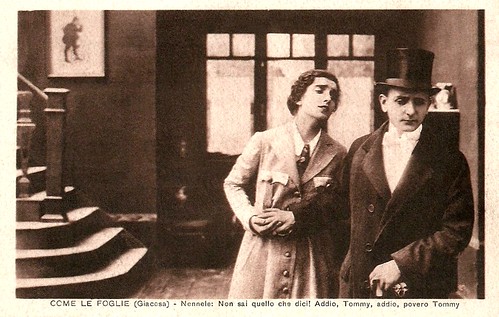
Italian postcard. Photo: Tiber Film, Roma. Publicity still for Come le foglie/Like the Leaves (Gennaro Righelli, 1917). Maria Jacobini (Nennele) and Alberto Collo (Tommy). Translation caption: Nennele: You don't know what you're saying! Farewell, Tommy, farewell, poor Tommy!
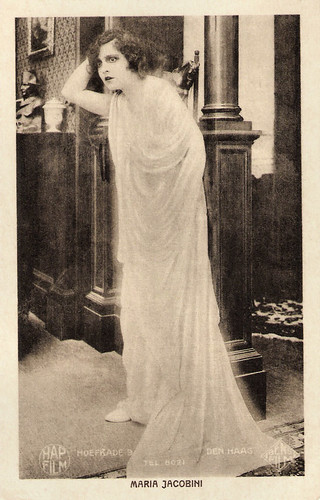
Dutch postcard by E & B, no. 518. Photo: HAP Film, Den Haag / Bens Film. Possibly this card uses a still from L'onestà del peccato/La fine di un vile/The Wife He Neglected (Augusto Genina, 1918), in which Jacobini wears a similar dress. The film was restored by the Museo Nazionale del Cinema in Turin and shown at the Cinema Ritrovato Festival in Bologna in 2017.

Italian postcard by Ed. G.B. Falci, Milano, no. 101. Maria Jacobini and Lido Manetti in Il richiamo/The Call (Gennaro Righelli, 1921).

Spanish collector card in the Escenas selectas de cinematografia series. Maria Jacobini in La Bohème/Boheme - Künstlerliebe (Gennaro Righelli, 1923), based on the novel by Henri Murger, which later was turned into an opera by Giacomo Puccini.

German postcard by Ross Verlag for Trianon Film-Verleih G.m.b.H., Berlin. Phot: Walter Lichtenstein. Maria Jacobini as Katja in Orient - Die Tochter der Wüste/Orient (Gennaro Righelli, 1924).

Italian postcard by G.B. Falci, Milano, no. 348. Maria Jacobini in the silent film La bocca chiusa (Guglielmo Zorzi, 1925).
After the First World War, the Italian film industry was in a deep crisis, and director Gennaro Righelli and his star Maria Jacobini decided to move to Germany.
In Berlin, the new centre of the European film industry, Jacobini and Righelli were enlisted by producer Jakob Karol and they founded a separate company called Maria Jacobini GmbH.
Jacobini first starred in Bohème - Künstlerliebe/Bohème - Artists Love (Gennaro Righelli, 1923), playing the tormented and suffering Mimi. Her film partner was Wilhelm Dieterle, who would later become known as Hollywood director William Dieterle.
She often performed in Righelli's German films and other directors' films. She was directed by Jaap Speyer in Bigamie/Bigamy (1927), Robert Dinesen in Ariadne im Hoppegarten (1928) with Alfred Abel, Richard Oswald in Villa Falconieri (1928) opposite Hans Stüwe, and by Fedor Ozep in the German-Russian coproduction Der lebende Leichnam/Zhivoy trup/The Living Corpse (1929), based on the play by Leo Tolstoy.
These productions were shot all over Europe, and Jacobini even filmed in Africa for Die Frauengasse von Algier/The Street of Women of Algiers (Wolfgang Hoffmann-Harnisch, 1927) with Camilla Horn.

Italian postcard, no. 430. Photo: Maria Jacobini and Lido Manetti in the silent film Addio giovinezza/Goodbye Youth (Augusto Genina, 1918), an adaptation of the play by Sandro Camasio and Nino Oxilia.
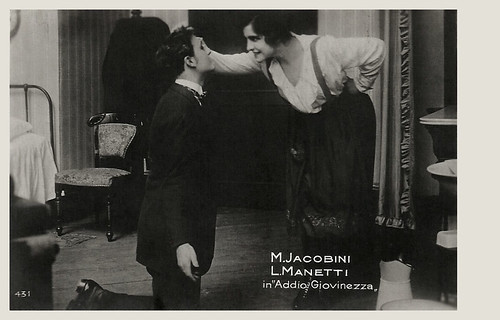
Italian postcard, no. 431. Photo: Maria Jacobini and Lido Manetti in the silent film Addio giovinezza/Good-Bye Youth (Augusto Genina, 1918).


Italian postcard by Ed. Vettori, Bologna, no. 346. Sent by mail in 1926. Maria Jacobini in Onestà del Peccato/The Wife He Neglected (Augusto Genina, 1918).

Italian postcard by Milano, Uff. Rev. Stampa, no. 891. Portrait of Maria Jacobini by Tito Corbella.

Italian postcard by Ed. Romeo Biagi, Bologna, no. 649.

Italian postcard by Dist. Ed. SARPIC, Bucarest, Romania, no. 330.

Italian postcard by G.B. Falci Ed. for Unica - Ciocolato Talmone al latte. Photo: Pittaluga Film. Maria Jacobini in Beatrice Cenci (Baldassarre Negroni, 1926).

Italian postcard by Ed. Bettini, Roma, no. 145.

German postcard by Ross Verlag, no. 3953/1, 1928-1929. Photo: Terra-Film.
Seductive man-eater
Maria Jacobini was born in Rome, Italy, in 1892. She was the sister of actress Diomira Jacobini. Their older sister Bianca had also started as an actress but interrupted her career after four films. Maria studied at the Accademia di Arte Drammatica di S. Cecilia, where her teachers were Virginia Marini and Eduardo Boutet. She made her stage debut at the company of Cesare Dondini Jr., where she mainly played secondary parts.
She was noticed by Ugo Falena, artistic director of the film company Film d'Arte Italiana. He offered her to work in the silent cinema. Her first short films were Lucrezia Borgia/Lucretia Borgia (Ugo Falena, 1910) featuring diva Francesca Bertini, and Beatrice Cenci (Ugo Falena, 1910), but her first important role was in Cesare Borgia (Gerolamo Lo Savio, 1912) again starring Bertini.
In 1912, Maria started to work at the Savoia company of Turin, as a seductive man-eater in short films like Pantera/Panther (1912), La zingara/The Gypsy (Sandro Camasio, 1912), and L'onta nascosta/The Hidden Shame (1912).
From 1913 on, she played her more dramatic roles as the lead in Giovanna d'Arco/Joan of Arc (Ubaldo Maria del Colle, 1913), In hoc signo vinces/The Triumph of an Emperor (Nino Oxilia, 1913) and Ananke (Nino Oxilia, 1915) with Leda Gys and her sister Diomira Jacobini.
Jacobini worked for pioneering film studios like Pasquali and Celio. Maria gave good performances in the melancholic Come le foglie/Like the Leaves (Gennaro Righelli, 1916) based on Giuseppe Giacosa's stage play, and in the touching Addio Giovinezza/Good-bye Youth (Augusto Genina, 1918). She made a series of films with director Gennaro Righelli such as Il viaggio/The Journey (1921), based on a novel by Luigi Pirandello, and Cainà - la figlia dell'isola/Cainà - the Daughter of the Island (1923), shot in Sardinia.

Italian postcard by Ed. A. Traldi, Milano, no. 713.

Italian postcard. Photo: Tiber Film. Publicity still for Come le foglie/Like the Leaves (Gennaro Righelli, 1917), based on the stage play by Giuseppe Giacosa. Father Giovanni (Ignazio Lupi) unites his daughter Nennele (Maria Jacobini) with his cousin Massimo (Guido Guiducci). Translation caption: Nennele: Shall I call him? Massimo! Content of the film: After a life of spendthrifts, the Rosati family is ruined. Father Giovanni (Ignazio Lupi) accepts work from his cousin Massimo (Guido Guiducci). Hitherto neglected as too serious and workaholic, Massimo becomes the head of the family and takes care of the son and daughter of Giovanni, Tommy (Alberto Collo) and Nennele (Jacobini), and their stepmother Giulia (Floriana). Tommy and Giulia remain weak spirits, but after an attempted suicide, Nennele realises Massimo's force and unites with him.

Italian postcard. Photo: Tiber Film, Roma. Publicity still for Come le foglie/Like the Leaves (Gennaro Righelli, 1917). Maria Jacobini (Nennele) and Alberto Collo (Tommy). Translation caption: Nennele: You don't know what you're saying! Farewell, Tommy, farewell, poor Tommy!

Dutch postcard by E & B, no. 518. Photo: HAP Film, Den Haag / Bens Film. Possibly this card uses a still from L'onestà del peccato/La fine di un vile/The Wife He Neglected (Augusto Genina, 1918), in which Jacobini wears a similar dress. The film was restored by the Museo Nazionale del Cinema in Turin and shown at the Cinema Ritrovato Festival in Bologna in 2017.

Italian postcard by Ed. G.B. Falci, Milano, no. 101. Maria Jacobini and Lido Manetti in Il richiamo/The Call (Gennaro Righelli, 1921).

Spanish collector card in the Escenas selectas de cinematografia series. Maria Jacobini in La Bohème/Boheme - Künstlerliebe (Gennaro Righelli, 1923), based on the novel by Henri Murger, which later was turned into an opera by Giacomo Puccini.

German postcard by Ross Verlag for Trianon Film-Verleih G.m.b.H., Berlin. Phot: Walter Lichtenstein. Maria Jacobini as Katja in Orient - Die Tochter der Wüste/Orient (Gennaro Righelli, 1924).

Italian postcard by G.B. Falci, Milano, no. 348. Maria Jacobini in the silent film La bocca chiusa (Guglielmo Zorzi, 1925).
Berlin
After the First World War, the Italian film industry was in a deep crisis, and director Gennaro Righelli and his star Maria Jacobini decided to move to Germany.
In Berlin, the new centre of the European film industry, Jacobini and Righelli were enlisted by producer Jakob Karol and they founded a separate company called Maria Jacobini GmbH.
Jacobini first starred in Bohème - Künstlerliebe/Bohème - Artists Love (Gennaro Righelli, 1923), playing the tormented and suffering Mimi. Her film partner was Wilhelm Dieterle, who would later become known as Hollywood director William Dieterle.
She often performed in Righelli's German films and other directors' films. She was directed by Jaap Speyer in Bigamie/Bigamy (1927), Robert Dinesen in Ariadne im Hoppegarten (1928) with Alfred Abel, Richard Oswald in Villa Falconieri (1928) opposite Hans Stüwe, and by Fedor Ozep in the German-Russian coproduction Der lebende Leichnam/Zhivoy trup/The Living Corpse (1929), based on the play by Leo Tolstoy.
These productions were shot all over Europe, and Jacobini even filmed in Africa for Die Frauengasse von Algier/The Street of Women of Algiers (Wolfgang Hoffmann-Harnisch, 1927) with Camilla Horn.

Italian postcard, no. 430. Photo: Maria Jacobini and Lido Manetti in the silent film Addio giovinezza/Goodbye Youth (Augusto Genina, 1918), an adaptation of the play by Sandro Camasio and Nino Oxilia.

Italian postcard, no. 431. Photo: Maria Jacobini and Lido Manetti in the silent film Addio giovinezza/Good-Bye Youth (Augusto Genina, 1918).

Italian postcard by G.B. Falci, Milano. Photo: Maria Jacobini and Amleto Novelli in La preda/The Prey (Guglielmo Zorzi, 1921).
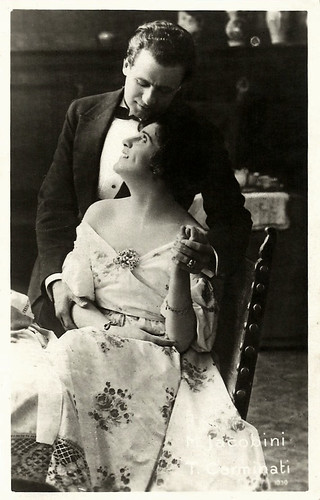
Italian postcard by Ed. Vettori, Bologna. Photo: probably publicity still for L'articolo IV (Gennaro Righelli, 1918) in which Jacobini and Tullio Carminati were the leading actors. The film is about Duchess Jenny who offers her hand to the only man who didn't court her, the Count d'Hauteville. She has a condition, though: for a long time the two must first live together as mere friends and if they don't get along they will divorce. Will both keep this promise? The card suggests otherwise...
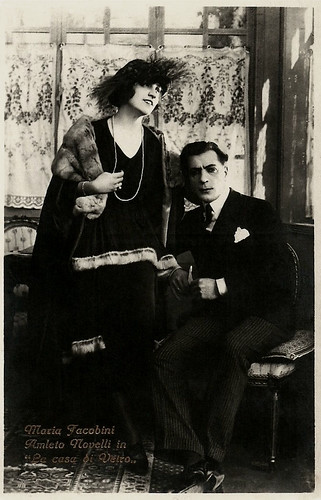
Italian postcard by G.B. Falci, Milano, no. 13. Photo: Maria Jacobini and Amleto Novelli in La casa di vetro/The Glass House (Gennaro Righelli, 1920).
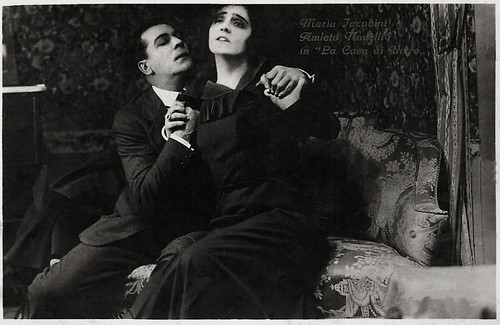
Italian postcard by G.B. Falci, Milano. Photo: publicity still for La casa di vetro/The Glass House (Gennaro Righelli, 1920) with Jacobini and Amleto Novelli.
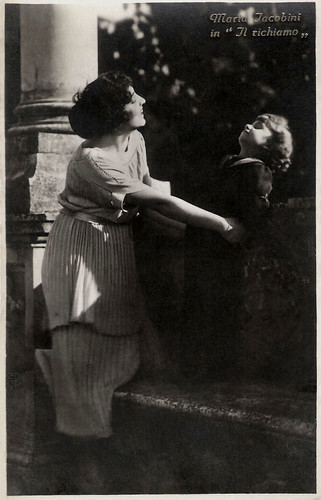
Italian postcard by G.B. Falci, Milano, no. 92. Photo: publicity still for Il richiamo/The Call (Gennaro Righelli, 1921).
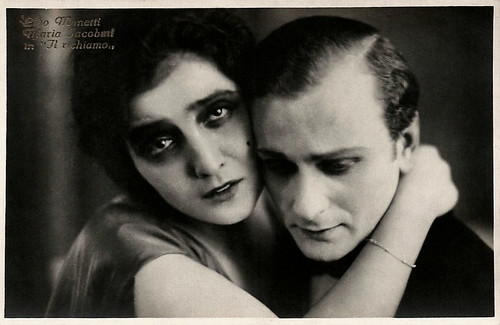
Italian postcard by G.B. Falci, Milano, no. 67. Publicity still of Maria Jacobini and Lido Manetti in Il richiamo/The Call (Gennaro Righelli, 1921). A print of this film is in the Komiya Collection at the National Film Center in Tokyo. A restored version was shown at the festival Cinema Ritrovato in Bologna in 2012.
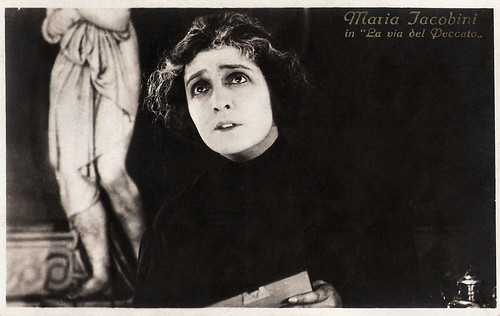
Italian postcard. The film title on this card is a mystery. Maria Jacobini did not play in La via del peccato (Amleto Palermi, 1925), but her sister Diomira Jacobini did. Maria acted in a film called L'onestà del peccato (Augusto Genina, 1918). But this is probably a card for La bocca chiusa/The Closed Mouth (Guglielmo Zorzi, 1925), for the moment when the aged Maria, now a domestic to a lord, sees a childhood photo and realizes her employer is her son.

Italian postcard by G.B. Falci, Milano. Photo: Maria Jacobini in La bocca chiusa/The Closed Mouth (Guglielmo Zorzi, 1925) with Lido Manetti.

Italian postcard by Ed. G.B. Falci, Milano, no. 106. Photo: S.A. Stefano Pittaluga. Maria Jacobini and Malcolm Tod in the late silent film Il carnevale di Venezia/The Carnival of Venice (Mario Almirante, 1928).
Marginal roles
In the second half of the 1920s, Maria Jacobini performed also in a few Italian films such as La bocca chiusa/The Closed Mouth (Guglielmo Zorzi, 1925) opposite Lido Manetti a.k.a. Arnold Kent and Carmen Boni, Beatrice Cenci (Baldassarre Negroni, 1926), and Il carnevale di Venezia/The Carnival of Venice (Mario Almirante, 1928).
In France, she did Maman Colibri/Mother Hummingbird (Julien Duvivier, 1929) with Franz Lederer. It was her final silent film.
With the coming of the sound cinema, Jacobini's roles became marginal, though she continued to play in films until her death.
In 1937 she became a teacher in acting at the new Roman film academy Centro Sperimentale di Cinematografia, where she gave lessons to new stars and actresses such as Alida Valli and Clara Calamai.
Her final film was La donna della montagna/The Mountain Woman (Renato Castellani, 1943) with Marina Berti. Maria Jacobini died a year later, in 1944 in Rome. She was 52.
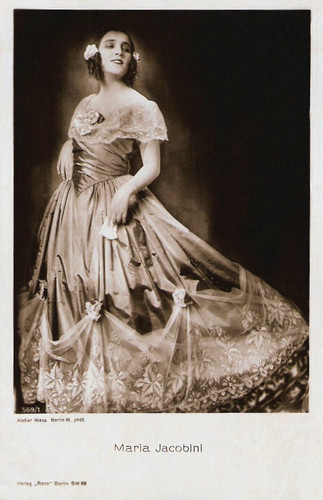
German postcard by Ross Verlag, no. 569/1, 1930-1931. Photo: Atelier Riess, Berlin.
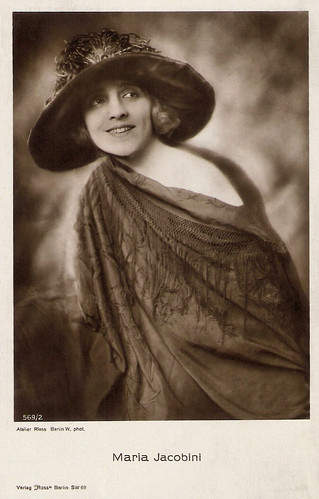
German postcard by Ross Verlag, no. 569/2, 1919-1924. Photo: Atelier Riess, Berlin.

Austrian postcard by Iris Verlag, no. 717. Photo: Sascha Film.
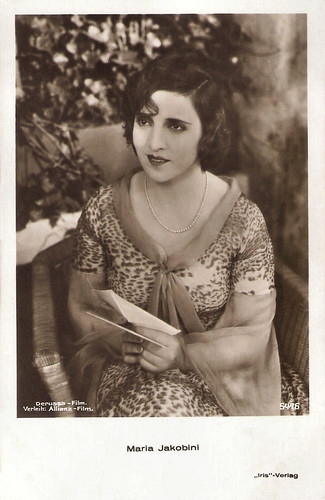
Austrian postcard by Iris Verlag, no. 5476. Photo: Derussa-Film / Allianz-Film.
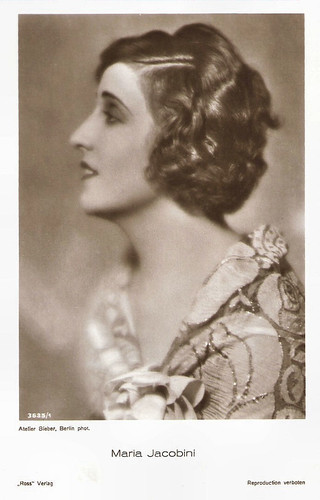
German postcard by Ross Verlag, no. 3635/1, 1928-1929. Photo: Atelier Bieber, Berlin.
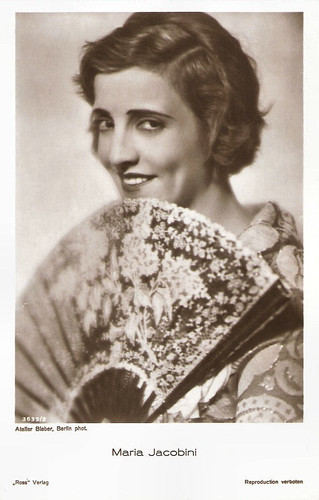
German postcard by Ross Verlag, no. 3635/2, 1928-1929. Photo: Atelier Bieber, Berlin.
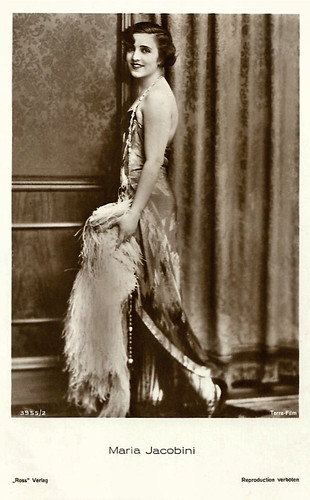
German postcard by Ross Verlag, no. 3955/2, 1928-1929. Photo: Terra-Film.
Sources: Vittorio Martinelli (Le dive del silenzio), Caterina Cerra (Treccani.it - Italian), Wikipedia (English and Italian) and IMDb.
No comments:
Post a Comment